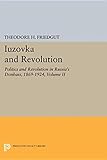Iuzovka and Revolution, Volume II : Politics and Revolution in Russia's Donbass, 1869-1924 / Theodore H. Friedgut.
Material type: TextSeries: Princeton Legacy Library ; 5180Publisher: Princeton, NJ : Princeton University Press, [2017]Copyright date: ©1994Description: 1 online resource (544 p.) : 11 halftones 2 mapsContent type:
TextSeries: Princeton Legacy Library ; 5180Publisher: Princeton, NJ : Princeton University Press, [2017]Copyright date: ©1994Description: 1 online resource (544 p.) : 11 halftones 2 mapsContent type: - 9781400887316
- 306/.0947/71 19
- HN530.D645 F75 2014eb
- online - DeGruyter
| Item type | Current library | Call number | URL | Status | Notes | Barcode | |
|---|---|---|---|---|---|---|---|
 eBook
eBook
|
Biblioteca "Angelicum" Pont. Univ. S.Tommaso d'Aquino Nuvola online | online - DeGruyter (Browse shelf(Opens below)) | Online access | Not for loan (Accesso limitato) | Accesso per gli utenti autorizzati / Access for authorized users | (dgr)9781400887316 |
Frontmatter -- CONTENTS -- LIST OF ILLUSTRATIONS -- LIST OF TABLES -- PREFACE -- ACKNOWLEDGMENTS -- PART I. Political Forces in the Donbass -- CHAPTER 1. Government and Capital in the Donbass -- CHAPTER 2. Labor: Early Strikes and First Organizations -- CHAPTER 3. The Maturation of the Working Class -- CHAPTER 4. Organizing Revolution -- PART II. Years of Contention: 1900–1917 -- CHAPTER 5. The Year 1905 in the Donbass -- CHAPTER 6. Years of Uncertainty: 1906–1914 -- CHAPTER 7. The World War in the Donbass -- PART III. Revolution, Civil War, and Reconstruction -- CHAPTER 8. Iuzovka and Revolution, 1917 -- CHAPTER 9. The October That Wasn't -- CHAPTER 10. Interlude of Occupations: Iuzovka in the Civil War -- CHAPTER 11. From Iuzovka to Stalino: The New Russia Reborn -- CHAPTER 12. Conclusions: Modernization, Community, and Stability -- GLOSSARY OF RUSSIAN TERMS AND ABBREVIATIONS -- BIBLIOGRAPHY -- INDEX
restricted access online access with authorization star
http://purl.org/coar/access_right/c_16ec
In 1870 the Welsh ironmaster John James Hughes left his successful career in England and settled in the barren and underpopulated Donbass region of the Ukrainian steppe to found the town of Iuzovka and build a large steel plant and coal mine. Theodore Friedgut tells the remarkable story of the subsequent economic and social development of the Donbass, an area that grew to supply seventy percent of the Russian Empire's coal and iron by World War I. The first volume of this two-volume study focused on the social and economic development of the Donbass, while the second volume is devoted to political analysis. While revealing the grand and tragic sweep of revolutionary events in this region, Friedgut also offers a fascinating picture of the heterogeneous population of these frontier settlements. He analyzes the instability of the revolutionary movement, and in particular the absence of a significant stratum of "worker-intelligentsia," and the inhibiting effect that this had on the development of an indigenous workers' movement. In addition, he reinforces the theory that World War I intensified existing social tensions in the Russian Empire, cutting short the slow but steady modernization of Russia's society and politics and creating the social crisis that led to the collapse of the old regime.Originally published in 1994.The Princeton Legacy Library uses the latest print-on-demand technology to again make available previously out-of-print books from the distinguished backlist of Princeton University Press. These editions preserve the original texts of these important books while presenting them in durable paperback and hardcover editions. The goal of the Princeton Legacy Library is to vastly increase access to the rich scholarly heritage found in the thousands of books published by Princeton University Press since its founding in 1905.
Mode of access: Internet via World Wide Web.
In English.
Description based on online resource; title from PDF title page (publisher's Web site, viewed 30. Aug 2021)


